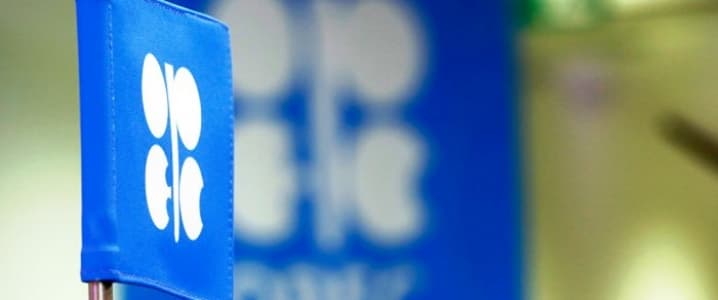Inventories 350 MMBO above historical average
An extension of the OPEC production cuts should normalize global inventories this year, according to research by KLR Group.
Announced on September 28, 2016, OPEC agreed to limit production to 32.5 MMBOEPD in the first half of 2017. According to KLR, OPEC production over this period will actually average 32 MMBOEPD, due to lower than agreed Saudi output and Nigerian and Libyan unrest.
Kuwait, Iraq, Saudi Arabia want extended cuts
Many OPEC member countries have expressed support at extending the cuts, which will expire in June. Kuwait, Iraq, Algeria and Angola have all stated that prolonging the production cuts is necessary to rebalance the markets. While global inventories have declined, according to KLR total inventory is still about 350 MMBO above the 2010-2014 average.
On Tuesday Saudi Arabia told OPEC officials that it wants to extend production cuts for an additional six months. According to the Wall Street Journal, OPEC ministers hope to reduce storage inventories by about 260 MMBO before resuming full production. Related: China Ready To Cut Oil Supplies To North Korea
KLR’s analysis seems to confirm that another six months of reduced production are needed to reduce inventories, projecting that the oil market will be “meaningfully undersupplied” if cuts are extended. Most of the supply drawdown will occur in the second half of 2017, and after 2018 markets will become more balanced.
(Click to enlarge)
The IEA reaches similar conclusions in its most recent Oil Market Report. The IEA predicts a total stock change of about 1 MBOPD in Q2 2017, with further reductions later in the year if cuts are extended. However, the IEA has revised its demand growth expectations downward, meaning balancing will take longer than previously predicted.
(Click to enlarge)
Saudi Arabia’s motivations go beyond reducing the global oil surplus.
The kingdom is planning to complete an IPO for Saudi Aramco, its national oil company. While only 5 percent of the company will be offered in the IPO, Saudi Arabia hopes to raise $100 billion, giving the NOC a $2 trillion valuation. The plan by Saudi Arabia, if workable, would create by far the largest valuation in the market today. But the high price, and therefore Saudi Arabia’s proceeds from the IPO, is in doubt.
The downturn in oil prices affected not just American producers, but nations with nationalized oil production. Saudi Arabia is highly dependent on Aramco for revenue, and lower prices created significant government budget deficits. Russia is another example. Putting forth an Aramco IPO is seen as a way for the nation to raise revenue, replenishing cash reserves that were decimated during the downturn.
Analyzing the market conditions, the background of oil development in Saudi Arabia and the geopolitics of the Middle East, Tom Petrie, founder and chairman of Petrie Partners, gave his perspective on the Aramco IPO at the EnerCom Dallas investor conference in early March:
“There’s a determined effort to bring Saudi Aramco public. … This really is transformational if they can pull it off,” Petrie said. “The deputy crown prince who is now 32 years old is beginning to put into place a dramatic set of changes: cutbacks in subsidies to the Saudi citizens, looking to instill the notion that work in itself is a worthy activity—that’s not part of the historic Saudi culture.”
Petrie pointed out that this is not just the deputy crown prince talking to the royal family and the extended family of about 30,000-40,000 people, but rather he is talking to 19 million citizens of Saudi Arabia. “And we still have the last vestiges of ten sons of the founder of the country of almost 120 years ago, a number of whom are less than fully committed to the changes that the deputy crown prince is putting forth."
Related: China’s Electric Vehicle Market Is Unbeatable
“That said they made the decision and they’re fully committed,” Petrie said. He said that when they first put forward the idea of selling a part of Saudi Aramco there was a lot of talk in the West about selling the downstream, selling the midstream, selling the tankers or the refineries, “and then it became clear—‘no, we’re talking about selling 5 percent of the company and by the way we think it’s worth $2 trillion dollars at the price we want to get for that 5 percent.”
$2 trillion not realistic
Petrie said that valuation of the company will be center stage. “Wood Mackenzie has come out with a controversial report—as far as the Saudis are concerned—that [the 5 percent of Saudi Aramco] would be valued at far less than the $2 trillion.”
At the end of March, Saudi Arabia sharply cut taxes on Aramco, from 85 percent to 50 percent. This is viewed as a move to make the company more attractive to global energy investors, and raising its potential valuation.
If continued cuts can serve to stabilize oil prices at higher levels, this will also buoy the valuation—an additional motivation for the kingdom to lobby its coalition to extend production cuts past June.
By Oil and Gas 360
More Top Reads From Oilprice.com:
- Novatek Aims To Dethrone Gazprom With Qatar Deal
- Could Guyana Become The Next Oil Hot Spot?
- IEA: Oil Markets Are Balancing At A Rapid Pace




















